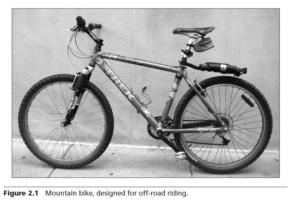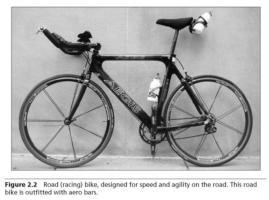While all bikes are generally the same, with a seat (saddle), two wheels, and a frame, there are many variables that affect the type of bicycle appropriate for you. From upright bikes with internal gears designed for city riding to single-speed racing bikes, there is a wide variety of bikes currently on the market. The following section is an introduction to the most common bikes and the differences between them.
Mountain Bikes
With fat, low-pressure tires and durable frames, mountain bikes are designed for off-road riding, through gravel and dirt, and over rocks and roots (figure 2.1). Because the tires on mountain bikes use less pressure than road bike tires, they offer the rider a little bit of shock absorption and greater traction. A wide gear range enables you to climb steep grades. Powerful brakes, shifters at your fingertips, and upright or flat handlebars provide control and stability. Front and rear suspension can smooth out the bumps in the trail.

Multipurpose mountain bikes are popular and offer off-road versatility, but they have less city-riding functionality. Knobby tires give more rolling resistance, which makes them harder to ride on the road. They are designed for use off road. Mountain bikes have smaller frame dimensions and are easier and more stable to corner and maneuver over curbs and rocks. They generally feature 26-inch wheels and wide (1- to 2.5-inch) tires. Because the frame geometry is frequently more compact, with sloping top tubes and short wheelbases, attaching commuting gear to a mountain bike may be more difficult. In addition, the rider’s position leans forward more aggressively. This may put the rider in a less upright position than that of a comfort bike. These bikes are often the perfect selection for children and younger adults because they are fun, versatile, and usually the least expensive bikes in a shop.
Like any bike, mountain bikes can be used for town riding or commuting, but not all the special features found on a nice mountain bike enhance a city ride. Many competitive mountain bike frames are small, designed for ease in maneuverability, not comfort, and the shocks can slow a bike down and add unnecessary weight.
Road (Racing) Bikes
Road bikes are designed to be ridden on smooth surfaces (figure 2.2). Built for speed, with narrow, smooth high-pressure tires, the road bike is a highly efficient ride. The drop handlebars (or drop bars, curved in the shape of a ram’s horn) let you adjust your position to achieve maximum efficiency while climbing, descending, or relaxing. Wheel rims tend to be made of lightweight material—strong, but not ideal for carrying large loads or riding rough terrain. The wheels on a road bike are generally called 700c, which is an old French measurement that means they are a little smaller than 27 inches in diameter. This is a typical wheel size for working-class bikes around the world, although some road bikes come with 650c wheels. Road bikes adapted for triathlons (competitions involving three races: swimming, biking, and running) are designed with steeper seat tube angles to bring the rider into an even more aggressive and powerful position and are often outfitted with accessories such as aero bars (handlebars or handlebar attachments that allow the rider to assume a lower, more aerodynamic upper-body position; see figure 2.2) and bladed spokes (spokes that have been flattened for increased aerodynamics) that decrease wind resistance.

Racing bikes are designed for speed and position a cyclist in a competitive, compact position. High-end racing bikes are intended to be very light, wind resistant, responsive to each pedal stroke, and easy for skilled riders to turn and corner quickly. Racing bike wheels can be very stiff and somewhat fragile, with extremely skinny, high-pressure tires to reduce rolling resistance, sometimes even at the expense of overall handling quality.
Racing bikes are fun and fast, but they often lack the ability to be used as a practical city bike because they won’t accept fenders or racks that hold bags. Their compact design makes the road bike less comfortable than most bikes on short rides; often the high-pressure tires are also less forgiving on urban pavement. In addition, while the quality of racing bikes varies greatly, these bikes are among the most expensive bikes and thus a target of bike thieves. Some people just don’t want to put wear and tear on their expensive weekend bike by riding around town, in bad weather, or on rough roads with pot holes. However, for people who like road bikes, one commuter solution is to buy an older road bike for city riding. Used bikes can sometimes be found at excellent prices.
Comfort (Hybrid) Bikes
These all-purpose bikes borrow features from both mountain and road bikes (figure 2.3). From the mountain bike, the comfort bike takes the wide gear range, upright riding position, and powerful brakes. Like a road bike, comfort bikes feature higher-pressure, medium-width tires that make for an efficient and comfortable ride.

Comfort-style bikes, or hybrids, have become popular in the United States. Comfort bikes are easy to mount and dismount; have an upright, comfortable position; and can accommodate baskets, bags, and commuting gear. Comfort bikes are not high-performance bikes; they are often heavier and less agile, but they can still handle high speeds and packed dirt paths. Because of increased popularity, there is a wide variety of styles and prices. Even expert bikers and racers can be found on cool comfort bikes for commuting and weekend jaunts. They generally have 700c wheels and flat handlebars as opposed to drop bars. They often have a wide range of gears for a variety of terrain.